The Crucial/Micron M500 Review (960GB, 480GB, 240GB, 120GB)
by Anand Lal Shimpi on April 9, 2013 9:59 AM ESTAnandTech Storage Bench 2011
Two years ago we introduced our AnandTech Storage Bench, a suite of benchmarks that took traces of real OS/application usage and played them back in a repeatable manner. I assembled the traces myself out of frustration with the majority of what we have today in terms of SSD benchmarks.
Although the AnandTech Storage Bench tests did a good job of characterizing SSD performance, they weren't stressful enough. All of the tests performed less than 10GB of reads/writes and typically involved only 4GB of writes specifically. That's not even enough exceed the spare area on most SSDs. Most canned SSD benchmarks don't even come close to writing a single gigabyte of data, but that doesn't mean that simply writing 4GB is acceptable.
Originally I kept the benchmarks short enough that they wouldn't be a burden to run (~30 minutes) but long enough that they were representative of what a power user might do with their system.
Not too long ago I tweeted that I had created what I referred to as the Mother of All SSD Benchmarks (MOASB). Rather than only writing 4GB of data to the drive, this benchmark writes 106.32GB. It's the load you'd put on a drive after nearly two weeks of constant usage. And it takes a *long* time to run.
1) The MOASB, officially called AnandTech Storage Bench 2011 - Heavy Workload, mainly focuses on the times when your I/O activity is the highest. There is a lot of downloading and application installing that happens during the course of this test. My thinking was that it's during application installs, file copies, downloading and multitasking with all of this that you can really notice performance differences between drives.
2) I tried to cover as many bases as possible with the software I incorporated into this test. There's a lot of photo editing in Photoshop, HTML editing in Dreamweaver, web browsing, game playing/level loading (Starcraft II & WoW are both a part of the test) as well as general use stuff (application installing, virus scanning). I included a large amount of email downloading, document creation and editing as well. To top it all off I even use Visual Studio 2008 to build Chromium during the test.
The test has 2,168,893 read operations and 1,783,447 write operations. The IO breakdown is as follows:
| AnandTech Storage Bench 2011 - Heavy Workload IO Breakdown | ||||
| IO Size | % of Total | |||
| 4KB | 28% | |||
| 16KB | 10% | |||
| 32KB | 10% | |||
| 64KB | 4% | |||
Only 42% of all operations are sequential, the rest range from pseudo to fully random (with most falling in the pseudo-random category). Average queue depth is 4.625 IOs, with 59% of operations taking place in an IO queue of 1.
Many of you have asked for a better way to really characterize performance. Simply looking at IOPS doesn't really say much. As a result I'm going to be presenting Storage Bench 2011 data in a slightly different way. We'll have performance represented as Average MB/s, with higher numbers being better. At the same time I'll be reporting how long the SSD was busy while running this test. These disk busy graphs will show you exactly how much time was shaved off by using a faster drive vs. a slower one during the course of this test. Finally, I will also break out performance into reads, writes and combined. The reason I do this is to help balance out the fact that this test is unusually write intensive, which can often hide the benefits of a drive with good read performance.
There's also a new light workload for 2011. This is a far more reasonable, typical every day use case benchmark. Lots of web browsing, photo editing (but with a greater focus on photo consumption), video playback as well as some application installs and gaming. This test isn't nearly as write intensive as the MOASB but it's still multiple times more write intensive than what we were running in 2010.
As always I don't believe that these two benchmarks alone are enough to characterize the performance of a drive, but hopefully along with the rest of our tests they will help provide a better idea.
The testbed for Storage Bench 2011 has changed as well. We're now using a Sandy Bridge platform with full 6Gbps support for these tests.
AnandTech Storage Bench 2011 - Heavy Workload
We'll start out by looking at average data rate throughout our new heavy workload test:
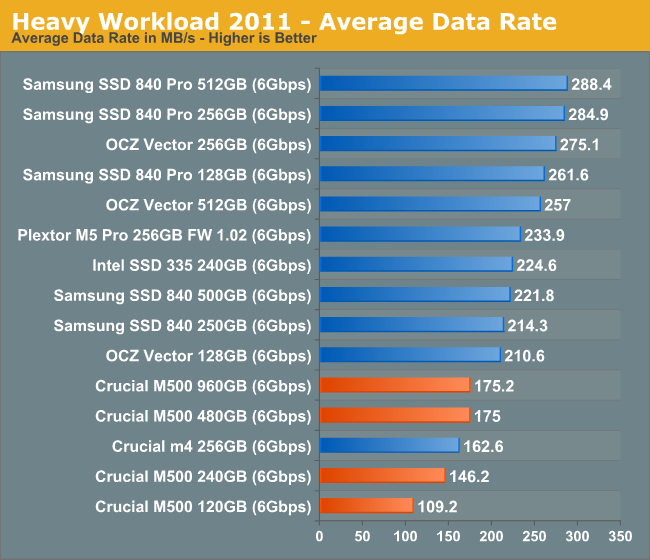
Our heavy workload from 2011 illustrates the culmination of everything we've shown thus far: the M500 can even be slower than the outgoing m4. There's no doubt in my mind that this is a result of the tradeoffs associated with moving to 128Gbit NAND die. The M500's performance is by no means bad, but it's definitely below what we've come to expect from Intel and Samsung flagships.
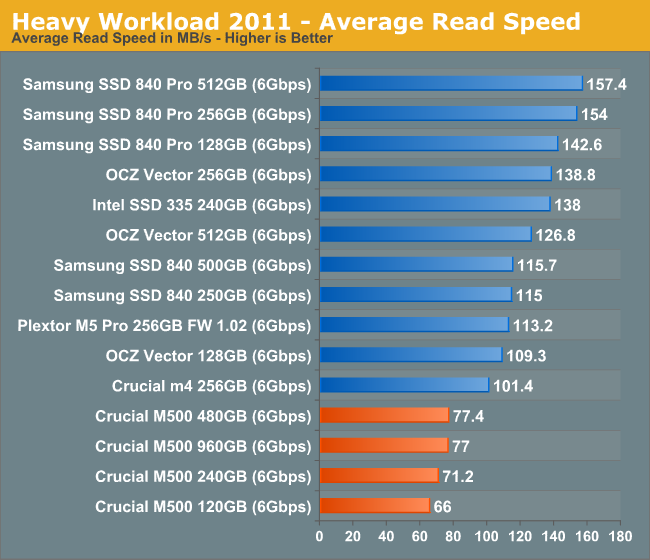
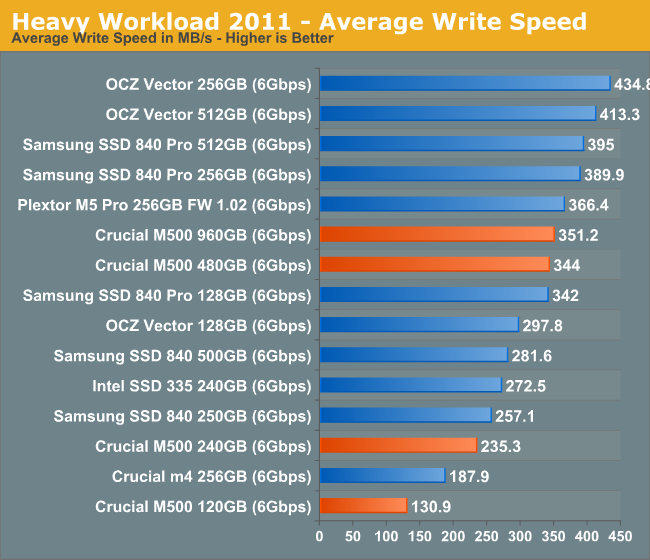
The next three charts just represent the same data, but in a different manner. Instead of looking at average data rate, we're looking at how long the disk was busy for during this entire test. Note that disk busy time excludes any and all idles, this is just how long the SSD was busy doing something:
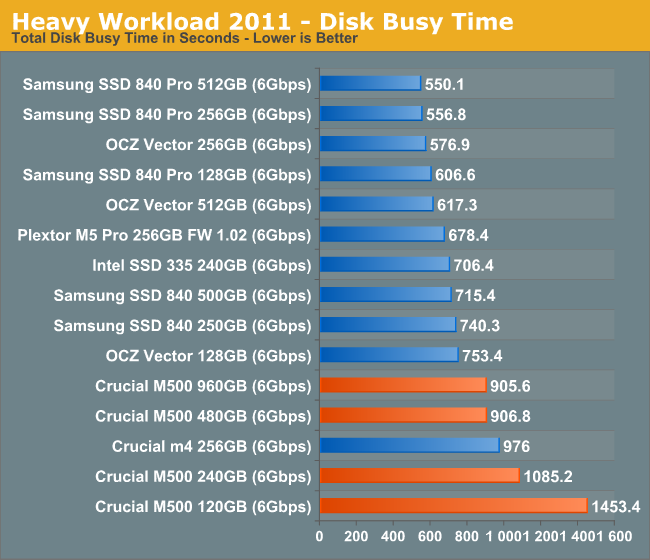
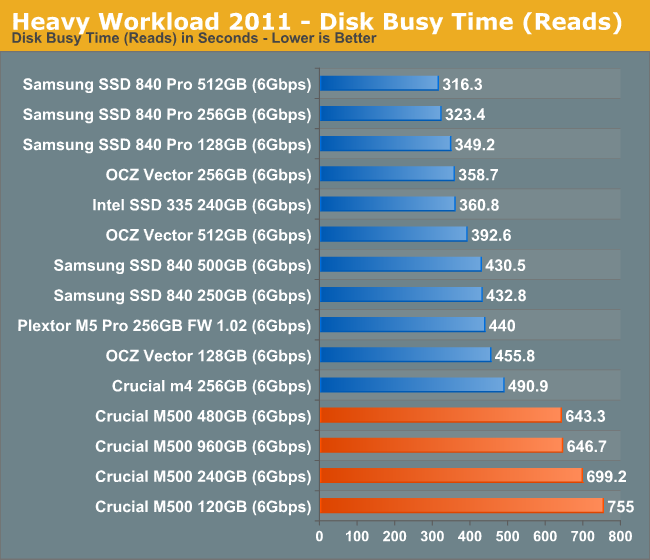
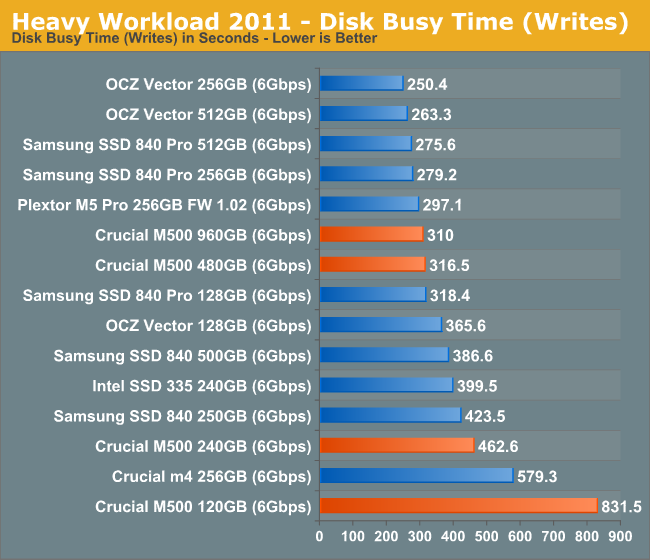










111 Comments
View All Comments
BHSPitMonkey - Tuesday, April 9, 2013 - link
Correction: "securily" should read "securely" in the section about encryption.iaco - Tuesday, April 9, 2013 - link
Only 72 TB of writes? That must be a mistake. That's even worse than Samsung's TLC NAND with 1000 write cycles. At 500 GB, 1000 cycles is equal to 500 TB. 3000 cycles for MLC NAND is 1500 TB. Anand, please tell me the spec is wrong, otherwise this drive is not worth the price.Anand Lal Shimpi - Tuesday, April 9, 2013 - link
That's directly from the M500 datasheet. Note that Intel rates the 335 at 20GB of writes per day for 3 years or 21.9TB but explicitly calls that out as a minimum endurance. I suspect that's what this 72TB rating is as well. Samsung doesn't publish similar numbers for the 840 and everyone comes up with their endurance numbers in different ways so they wouldn't likely be comparable either.The NAND is no less reliable than previous 20nm versions, so I have no reason to believe we won't see significantly longer lifespan out of the M500 than just 72TB of writes.
Take care,
Anand
microlithx - Tuesday, April 9, 2013 - link
If you look at Micron's data sheets, particularly at the enterprise SATA SSDs, you'll see they report 7 PB. They won't guarantee it but they'll probably reach that if you overprovision accordingly.NotablePerson - Tuesday, April 9, 2013 - link
What I'm confused about is how the 72TB endurance rating is the same across the board for all four of the SSDs. Shouldn't there be at least SOME variance in their ratings on account of the additional NAND?Kristian Vättö - Tuesday, April 9, 2013 - link
I don't have the datasheet with me (I'm travelling this week) but that 72TB was not sequential writes. IIRC it was 90% random and 10% sequential (and a couple of different IO sizes too), hence the endurance rating. Anand should be able to confirm the exact methodology but 72TB sounds normal in my ears, some have ~30TB (but 100% 4KB random writes).Solid State Brain - Wednesday, April 10, 2013 - link
I believe this is their way of telling buyers that they do not officially support or endorse enterprise usage (ie more than 40 GiB/day) on these drives, although their NAND flash memory is specced for way more than just 72 TiB of writes especially on higher capacity models.I would expect the 960 GB (1 TiB) drive to unofficially endure for at least 1.5 PiB of writes (at 2x write amplification).
Solid State Brain - Wednesday, April 10, 2013 - link
I meant to say that the 960 GB model (894.07 GiB) has 1 TiB of flash memory installed on its PCB. The "missing" capacity is for overprovisioning purposes.comomolo - Friday, May 3, 2013 - link
I can't believe they sell a 1TB drive that will day after fully writing it just 72 times.theduckofdeath - Tuesday, April 9, 2013 - link
This was a bit disappointing, I think. Hopefully a FW update or two will improve the numbers a bit, otherwise it just feels like a step backwards if you're not going for the 1TB model.